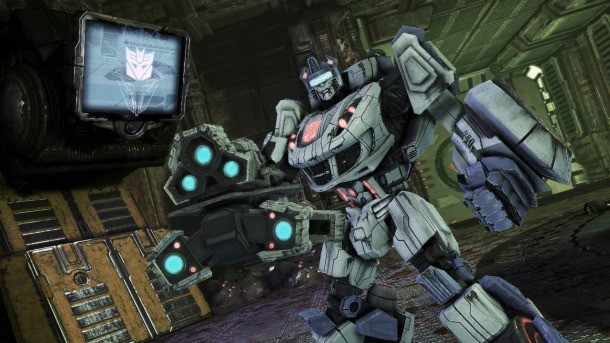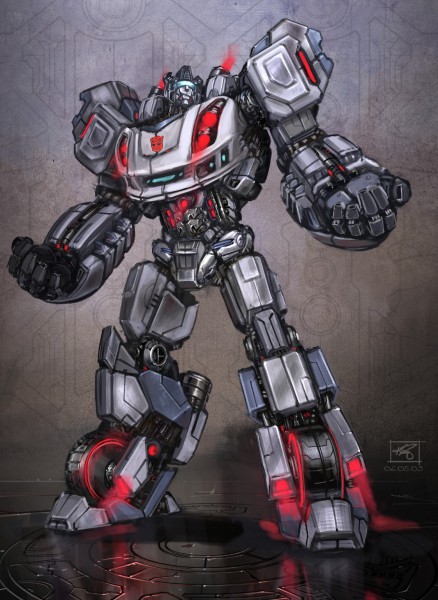Our extra-large special edition is here. Subscribe today and receive the 25% longer issue at no extra cost!
Fall Of Cybertron Deep Character Dive: Jazz

We’ve spent the month talking about some big ideas surrounding High Moon Studio’s upcoming Transformers: Fall of Cybertron. From a glimpse at the brand new weapons system to our announcement of the return of the Dinobots, there are a lot of new features to wrap your head around.
Today, we go deep on one small area of gameplay and character – a close-up look at the character Jazz. This Autobot should be familiar to anyone who watched the old 1980s cartoon, but he hasn’t had a central role in the Transformers storyline in recent years. That equation changes with Fall of Cybertron, as Jazz steps up as one of the main playable characters.
Like all of the characters in Fall of Cybertron, Jazz and the levels he plays are built to complement one another. The challenges and battles you’ll face match Jazz’s particular skill set and strengths. Along the way, you’ll get to know more about this redesigned character, including a unique gameplay mechanic that only Jazz can implement.
![]()
The Character
High Moon took a look at what Jazz’s character is all about, and came away with some clear ideas of what they wanted to accentuate. Jazz is a fast, highly capable lieutenant to Optimus Prime. He’s funny and brazen, but more than ready for a fight. He’s cool under pressure.
Those ideas helped to inform a new vision for how the character would act, move, and talk. The new Fall of Cybertron version of Jazz is an extremely competent spec ops fighter at the forefront of the war against the Decepticons. His great competency is balanced against a joking personality.
When players take control of Jazz, Optimus Prime sends he and his good buddy Cliffjumper to track down Grimlock and his squad of heavy hitters. Grimlock’s strike team has gone missing, and Jazz and Cliffjumper must follow the trail of destruction they left behind. As Jazz moves deeper into dangerous enemy territory, he will uncover some big secrets key to the Autobot’s escape from the planet.

The Transformation
As discussed in our piece on Animating the Transformers, High Moon wants each character’s transformation to represent their personality. After the transformation animation is complete, the visual representation of robot and vehicle form should speak to the nature of that particular character, as well as remain visually similar to the original 80s look.
In the case of Jazz, his transformation harkens back to the character’s love of music and culture. As Jazz flips from robot to futuristic car and back again, the animation looks like a break-dancing move in fast-forward.
His robot form replicates the original head shape of the Generation 1 character almost exactly. From behind, the character’s constantly rotating engine and pumping pistons are clearly visible, helping to indicate the kinetic energy inherent to Jazz. He’s smaller than many of the other Autobots, a trait that’s on display when he fights many of the enemies, like the Insecticons.
Meanwhile, his vehicle form is sleek but rounded, calling to mind the Porsche appearance that the character had in his original incarnation. Like the old toy, Jazz sports a snazzy spoiler – as much for style as for speed.
[NEXT UP: How do Jazz's levels play, and what ideas did High Moon try and abandon?]

Gameplay
Jazz and Cliffjumper develop a buddy film dynamic in the storyline, and their gameplay is also interwoven. Cliffjumper’s levels are strongly focused on stealth, as he enacts the ability to turn invisible and scout ahead. In contrast, Jazz’s levels often send him hurtling into danger.
The big distinction that sets Jazz apart from other characters in the game is his grapple. This device transforms out from his arm and shoots forth a beam of energy. Once it connects to a surface, it pulls Jazz up like a fast-moving tractor beam. No matter where you move in the game world, the grapple always tracks on your reticle and finds an appropriate grapple point somewhere nearby. As a result, Jazz’s levels are large and multi-tiered, encouraging players to zip from one location to the next. Constant momentum is the key to success. The enemies in Jazz’s level hone in on his location, and he needs to be gone by the time they find him.
The sequence we watched was a tense battle of snipers. Jazz comes equipped with an impressive sniper rifle to destroy enemies from afar. As described in our feature on Fall of Cybertron’s artificial intelligence, his opponents are strange, spider-like wallcrawlers with long-range energy beams that they shoot from their single, central eye.
As these beams desperately try to hone in on Jazz, he constantly drops to a lower level and zips up to a higher platform, shooting all the while. His speed and precision are on display. In close range combat, the end of Jazz’s arm transforms into a speedy dagger that can finish off his foes.
As Jazz’s adventure continues, he’ll come up against Shockwave’s Insecticon minions. In contrast to the feeling of these creatures in the Grimlock sequences, every Insecticon is a monstrous and overwhelming threat. Jazz’s mobility is equally important in these encounters, requiring him to stay ahead of the scrambling horde.
![]()
What Didn’t Work
While gamers only see the final product of a new gameplay mechanic like Jazz’s grapple system, developers often prototype numerous concepts before honing in on something that works.
Early on, the team explored the idea of allowing grappling not just to other platforms, but to walls and ceilings as well. The idea was exciting on paper. However, the prototype just didn’t hold up to repeated play. As it is, Jazz’s movements between platforms are fast and visually disorienting, at least until you get used to the trick. By adding walls and ceilings into the mix, Jazz would sometimes zip to a new location and appear to be standing on a totally different plane, sideways or even upside-down. It took the visual confusion to a whole new level, so it was ultimately scrapped.
In another attempt, the team created the grapple to function as a full physics-based momentum system. Like Bionic Commando or Tarzan, Jazz would swing out from a platform and release to reach another location. Once again, a cool idea in concept that turned out to be highly problematic. Because Jazz is one character among several that you play in Fall of Cybertron, this complex physics simulation was way too difficult to learn. It would take many minutes to get used to the way the grapple worked, and new players would easily fall and make mistakes.
Instead, the final grapple system plays into the elements of Jazz’s personality that the team wants to focus on. Like him, the grapple is quick and surefire. It never misses. The grapple keeps the action flowing and intense, offering a potent counterpoint to the Cliffjumper missions. It’s also easy to use; players can grasp and utilize the grapple almost right away, keeping the focus squarely on bringing down the Decepticon attackers, rather than learning movement techniques.
Perhaps the most exciting thing about our close look at Jazz is how he is just one of many characters receiving this kind of detail and attention. During our visit, we saw six distinct playable characters, and we know there are more on the way. Each one of the six we witnessed exhibited lots of personality and style, plus a unique gameplay experience that set them apart from the others.
Fall of Cybertron is a game built on variety. If each component of that varied mix of gameplay styles is as fun as Jazz looks to be, High Moon will have something exciting for gamers in the fall of 2012.

We have over half-a-dozen other unique features to help you explore Transformers: Fall of Cybertron. If you’re excited to learn more, click on the banner below to visit our game hub.

Get the Game Informer Print Edition!
Explore your favorite games in premium print format, delivered to your door.
- 10 issues per year
- Only $4.80 per issue
- Full digital magazine archive access
- Since 1991







